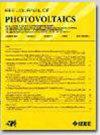Double-Perovskite Materials: Possibilities and Reality for a Better Solar Cell Device
IF 2.6
3区 工程技术
Q3 ENERGY & FUELS
引用次数: 0
Abstract
Despite the unprecedented certified efficiency of lead-based perovskite solar cells, their incorporation of potentially hazardous lead presents a considerable disadvantage, limiting their commercial feasibility. Halide double perovskites (DPVTs) have emerged as viable alternatives to lead-based perovskites. Nonetheless, obstacles such as inadequate solubility with traditional precursor solvents, an elevated indirect optical bandgap, and heterogeneous structural distributions have been recognized as impediments to their utilization in solar devices. Out of numerous compositions of DPVTs documented in the literature, only a limited number of structures have been effectively incorporated into solar cell systems. Furthermore, there is huge divergence between simulated and actual solar cell efficiencies. Comprehending the essential optoelectronic features and their underlying mechanisms is vital for formulating mitigating methods. This review examines possible DPVTs exhibiting favorable optoelectronic characteristics and photovoltaic metrics. We identify existing problems and innovative mitigation strategies regarding the robustness of DPVT structures, their optoelectronic properties, the simulation of photovoltaic performance, and the laboratory fabrication of DPVTs, while also providing insights into future prospects.双过氧化物材料:更好的太阳能电池装置的可能性与现实性
尽管铅基钙钛矿太阳能电池的效率得到了前所未有的认证,但它们含有潜在危险的铅,存在相当大的缺点,限制了它们的商业可行性。卤化物双钙钛矿(dpvt)已成为铅基钙钛矿的可行替代品。然而,诸如与传统前驱体溶剂溶解度不足,间接光学带隙升高以及非均质结构分布等障碍已被认为是阻碍其在太阳能器件中的应用的障碍。在文献记载的众多dpv组合物中,只有有限数量的结构被有效地纳入太阳能电池系统。此外,模拟和实际太阳能电池效率之间存在巨大差异。了解基本的光电特性及其潜在机制对于制定缓解方法至关重要。本文综述了可能具有良好光电特性和光伏指标的dpv。我们确定了DPVT结构的鲁棒性、光电性能、光伏性能模拟和DPVT的实验室制造方面存在的问题和创新的缓解策略,同时也提供了对未来前景的见解。
本文章由计算机程序翻译,如有差异,请以英文原文为准。
求助全文
约1分钟内获得全文
求助全文
来源期刊

IEEE Journal of Photovoltaics
ENERGY & FUELS-MATERIALS SCIENCE, MULTIDISCIPLINARY
CiteScore
7.00
自引率
10.00%
发文量
206
期刊介绍:
The IEEE Journal of Photovoltaics is a peer-reviewed, archival publication reporting original and significant research results that advance the field of photovoltaics (PV). The PV field is diverse in its science base ranging from semiconductor and PV device physics to optics and the materials sciences. The journal publishes articles that connect this science base to PV science and technology. The intent is to publish original research results that are of primary interest to the photovoltaic specialist. The scope of the IEEE J. Photovoltaics incorporates: fundamentals and new concepts of PV conversion, including those based on nanostructured materials, low-dimensional physics, multiple charge generation, up/down converters, thermophotovoltaics, hot-carrier effects, plasmonics, metamorphic materials, luminescent concentrators, and rectennas; Si-based PV, including new cell designs, crystalline and non-crystalline Si, passivation, characterization and Si crystal growth; polycrystalline, amorphous and crystalline thin-film solar cell materials, including PV structures and solar cells based on II-VI, chalcopyrite, Si and other thin film absorbers; III-V PV materials, heterostructures, multijunction devices and concentrator PV; optics for light trapping, reflection control and concentration; organic PV including polymer, hybrid and dye sensitized solar cells; space PV including cell materials and PV devices, defects and reliability, environmental effects and protective materials; PV modeling and characterization methods; and other aspects of PV, including modules, power conditioning, inverters, balance-of-systems components, monitoring, analyses and simulations, and supporting PV module standards and measurements. Tutorial and review papers on these subjects are also published and occasionally special issues are published to treat particular areas in more depth and breadth.
 求助内容:
求助内容: 应助结果提醒方式:
应助结果提醒方式:


